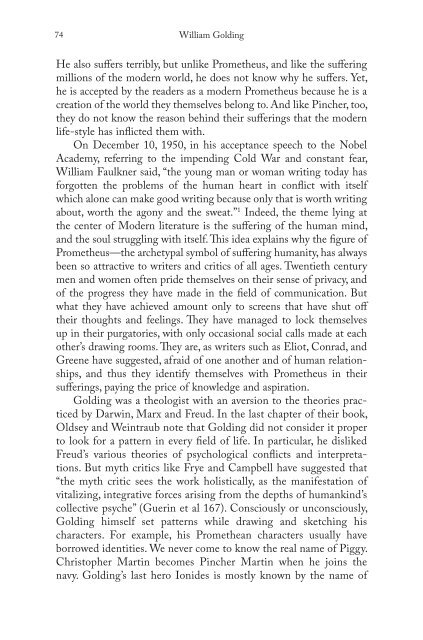Blooms Literary Themes - THE TRICKSTER.pdf - ymerleksi - home
Blooms Literary Themes - THE TRICKSTER.pdf - ymerleksi - home
Blooms Literary Themes - THE TRICKSTER.pdf - ymerleksi - home
You also want an ePaper? Increase the reach of your titles
YUMPU automatically turns print PDFs into web optimized ePapers that Google loves.
74<br />
William Golding<br />
He also suff ers terribly, but unlike Prometheus, and like the suff ering<br />
millions of the modern world, he does not know why he suff ers. Yet,<br />
he is accepted by the readers as a modern Prometheus because he is a<br />
creation of the world they themselves belong to. And like Pincher, too,<br />
they do not know the reason behind their suff erings that the modern<br />
life-style has infl icted them with.<br />
On December 10, 1950, in his acceptance speech to the Nobel<br />
Academy, referring to the impending Cold War and constant fear,<br />
William Faulkner said, “the young man or woman writing today has<br />
forgotten the problems of the human heart in confl ict with itself<br />
which alone can make good writing because only that is worth writing<br />
about, worth the agony and the sweat.” 1 Indeed, the theme lying at<br />
the center of Modern literature is the suff ering of the human mind,<br />
and the soul struggling with itself. Th is idea explains why the fi gure of<br />
Prometheus—the archetypal symbol of suff ering humanity, has always<br />
been so attractive to writers and critics of all ages. Twentieth century<br />
men and women often pride themselves on their sense of privacy, and<br />
of the progress they have made in the fi eld of communication. But<br />
what they have achieved amount only to screens that have shut off<br />
their thoughts and feelings. Th ey have managed to lock themselves<br />
up in their purgatories, with only occasional social calls made at each<br />
other’s drawing rooms. Th ey are, as writers such as Eliot, Conrad, and<br />
Greene have suggested, afraid of one another and of human relationships,<br />
and thus they identify themselves with Prometheus in their<br />
suff erings, paying the price of knowledge and aspiration.<br />
Golding was a theologist with an aversion to the theories practiced<br />
by Darwin, Marx and Freud. In the last chapter of their book,<br />
Oldsey and Weintraub note that Golding did not consider it proper<br />
to look for a pattern in every fi eld of life. In particular, he disliked<br />
Freud’s various theories of psychological confl icts and interpretations.<br />
But myth critics like Frye and Campbell have suggested that<br />
“the myth critic sees the work holistically, as the manifestation of<br />
vitalizing, integrative forces arising from the depths of humankind’s<br />
collective psyche” (Guerin et al 167). Consciously or unconsciously,<br />
Golding himself set patterns while drawing and sketching his<br />
characters. For example, his Promethean characters usually have<br />
borrowed identities. We never come to know the real name of Piggy.<br />
Christopher Martin becomes Pincher Martin when he joins the<br />
navy. Golding’s last hero Ionides is mostly known by the name of

















